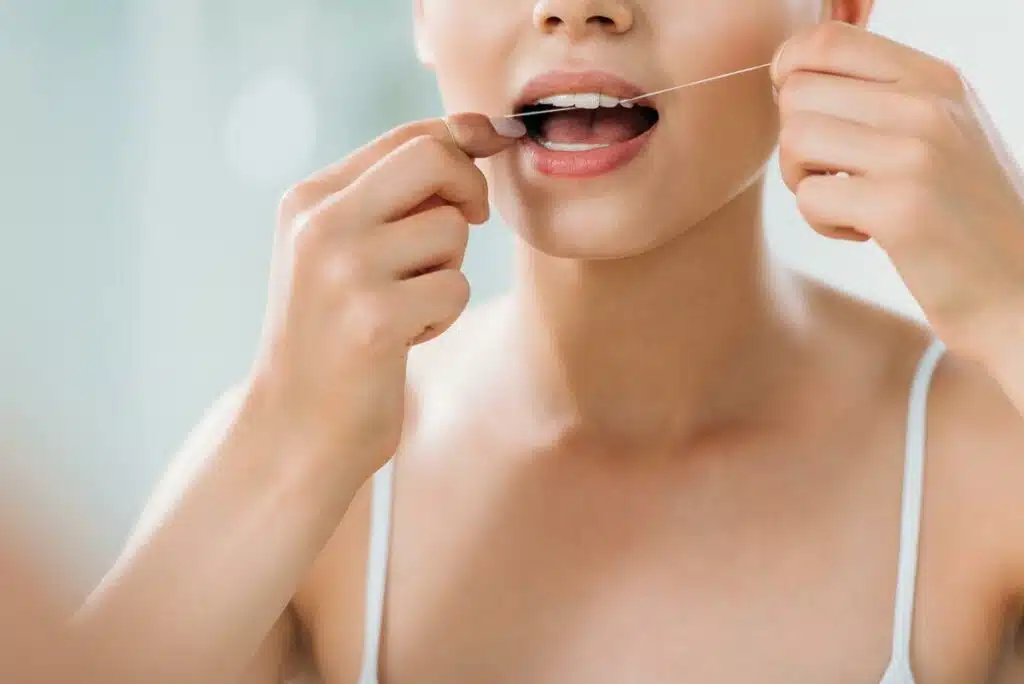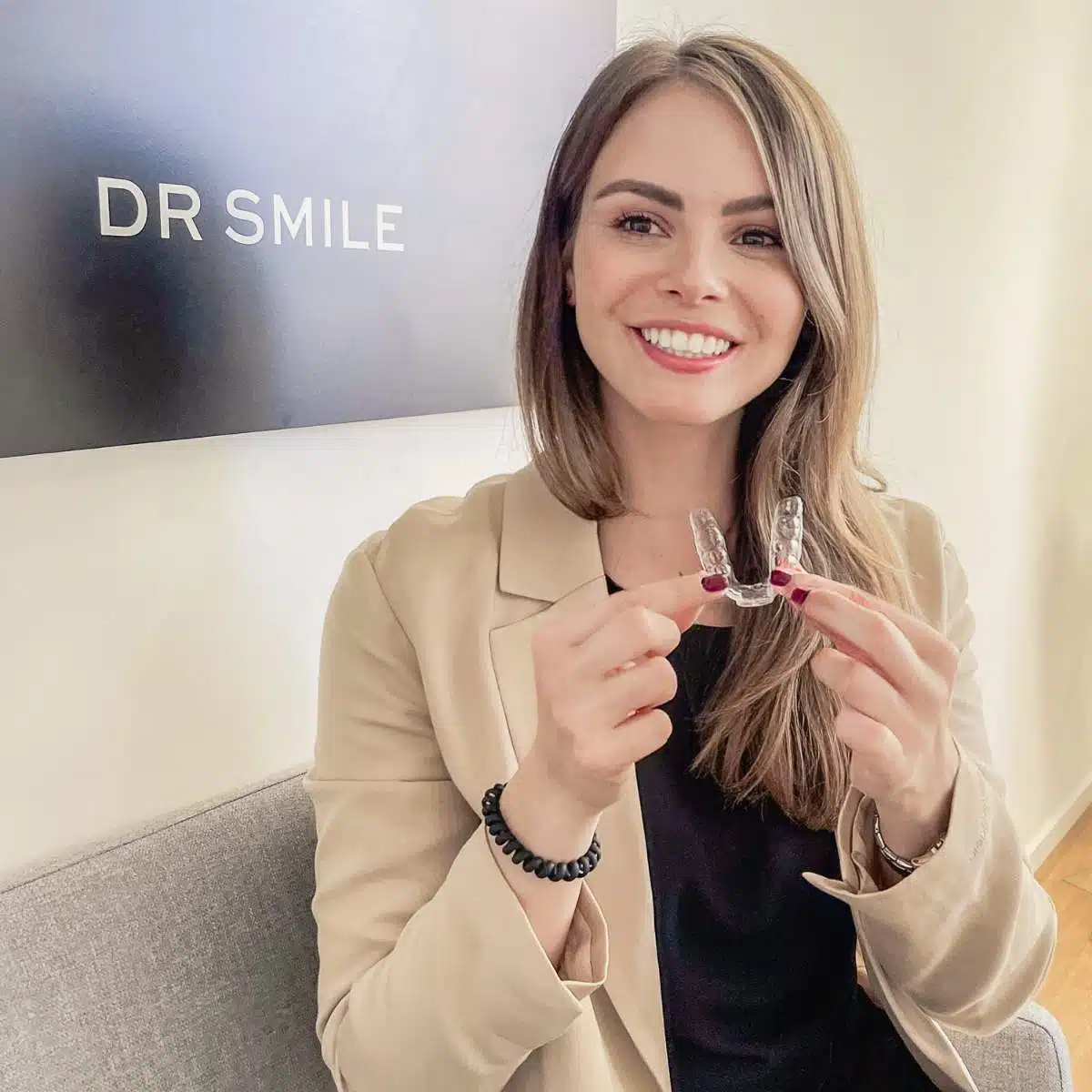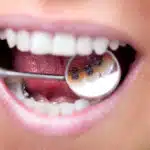Use dental floss correctly: Here you can find out how and how often it should be used and why it is so important for your dental health.
For many people, daily dental care is limited to brushing their teeth. However, this alone is often not enough to keep teeth and gums healthy.
This is where dental floss comes into play – a small but extremely effective tool that can make a big difference to your oral health.
In this article, you will learn how to use dental floss correctly, why it should be part of your daily dental care routine and how often you should use it.
| Get 150 € discount on your dental correction! |

Book a consultation appointment now at a nearby DrSmile partner practice and find out if teeth straightening with aligners is right for you.
The appointment is completely non-binding and does not involve any costs.
With the code “THATSMILE150” you will receive 150 € discount on the treatment.
What exactly is dental floss?
Dental floss is a thin thread that has been specially developed to remove food debris and plaque from between the teeth – i.e. from areas that a toothbrush often cannot reach.
Dental floss is usually made of nylon or Teflon and is available in different varieties, including waxed, unwaxed, flavored or specially designed for sensitive gums.
Some dental flosses are also available in the form of so-called flossettes, where the floss is stretched on a small plastic holder, which makes handling easier.
Why should you use dental floss?
Dental floss plays a crucial role in oral hygiene because it helps to clean areas that are often overlooked during normal tooth brushing.
Here are the most important reasons why you should use dental floss:
1. removal of plaque: Plaque is a sticky film of bacteria that constantly forms on the teeth. If plaque is not removed regularly, it can harden and become tartar, which in turn increases the risk of tooth decay and gum disease. Flossing helps to remove plaque from hard-to-reach spaces before it causes problems.
2. prevention of gum disease: Gum disease such as gingivitis is often caused by bacteria that accumulate in the gum line. If these bacteria are not removed, the gums can swell, bleed and recede. Regular flossing helps to remove these bacteria and thus prevent gum disease.
3. prevention of tooth decay: Most tooth decay occurs in the hard-to-reach spaces between teeth, where food debris and bacteria can remain undisturbed for longer. By using dental floss, you can effectively clean these areas and significantly reduce the risk of tooth decay.
4. fresh breath: Food residue left between the teeth can lead to bad breath. By using dental floss daily, you can remove these residues and ensure fresher breath.

Using dental floss correctly – this is the best way to proceed
The correct use of dental floss is crucial to achieve the desired results.
Here is a step-by-step guide on how to use dental floss correctly:
1. preparation: Cut off about 45 cm of dental floss and wrap the ends around the middle fingers of both hands so that about 5 cm of dental floss is stretched freely between the fingers. Hold the floss firmly with your thumbs and index fingers.
2. inserting the dental floss: Carefully insert the dental floss into the space between two teeth. Gently move the floss back and forth to guide it between the teeth. Be careful not to injure the gums.
3. cleaning the interdental spaces: Move the floss in a “C” shape around a tooth so that the floss lies close to the tooth surface. Gently pull the floss from top to bottom to remove plaque and food debris. Repeat this process for the adjacent tooth in the same space.
4. continue cleaning: Use a fresh piece of dental floss for each interdental space by winding the floss from one finger to the other. Proceed systematically so as not to miss any spaces.
5. finish: After cleaning the interdental spaces, you can rinse your mouth with water to remove any loosened particles. If necessary, clean the dental floss with warm water before disposing of it.
How often should dental floss be used?
For optimal oral health, you should use dental floss at least once a day.
It’s best to integrate flossing into your evening routine before you go to bed.
This will remove any food debris and plaque that has accumulated during the day and you won’t give bacteria a chance to do any damage overnight.

What types of dental floss are there?
There are different types of dental floss to suit different needs and preferences:
1. waxed dental floss: This dental floss is coated with a thin layer of wax, which makes it easier to insert into narrow interdental spaces. It is ideal if you have narrow interdental spaces or sensitive gums.
2. unwaxed dental floss: unwaxed dental floss consists of several nylon threads that can easily unravel when inserted into the interdental spaces. It is less smooth than waxed dental floss, but can clean more thoroughly.
3. flossettes: Flossettes are small holders to which a piece of dental floss is attached. They are particularly practical for people who have difficulty handling conventional dental floss or for people on the go.
4. flavored dental floss: Some dental flosses are flavored with mint or other aromas, which can make them more pleasant to use and provide fresh breath.
5. dental floss for sensitive gums: This dental floss is particularly gentle and less abrasive, making it ideal for people with sensitive gums or gum disease.

Conclusion: Why you shouldn’t ignore dental floss
Dental floss is an indispensable part of comprehensive oral hygiene.
It reaches areas that your toothbrush cannot and helps to remove plaque, bacteria and food debris that could otherwise lead to tooth decay, gum disease and bad breath.
Daily use of dental floss should therefore be just as natural as brushing your teeth.
If you use dental floss correctly and regularly, you will make a significant contribution to keeping your teeth and gums healthy.
Try out different types of dental floss to find the one that suits you best and make it an integral part of your daily dental care routine.
Your teeth and gums will thank you!
| Get 150 € discount on your dental correction! |

Book a consultation appointment now at a nearby DrSmile partner practice and find out if teeth straightening with aligners is right for you.
The appointment is completely non-binding and does not involve any costs.
With the code “THATSMILE150” you will receive 150 € discount on the treatment.
FAQs on the correct use of dental floss
Here we answer a few of the most frequently asked questions about using dental floss correctly.
Why should I use dental floss?
Dental floss helps to remove plaque and food debris from between the teeth – areas that your toothbrush often cannot reach.
By flossing regularly, you can significantly reduce the risk of tooth decay, gum disease and bad breath.
How often should I use dental floss?
For optimal oral health, you should floss at least once a day, ideally in the evening before going to bed.
This will remove any debris that has accumulated during the day and protect your teeth overnight.
Which type of dental floss is best for me?
The best dental floss depends on your individual needs.
Waxed floss is ideal if you have narrow interdental spaces, while unwaxed floss can clean more thoroughly.
Flossettes are practical if you have difficulty handling conventional dental floss.
Try out different variants to find the one that suits you best.
Can dental floss injure my gums?
If you use dental floss correctly, it should not injure your gums.
Insert the floss carefully into the spaces between your teeth and avoid forcing it into your gums.
When used gently, dental floss even helps to keep your gums healthy.
What do I do if I can’t use dental floss properly?
If you find it difficult to use dental floss correctly, you can use flossettes or interdental brushes.
These aids are often easier to use and offer similar benefits to conventional dental floss.
Isn’t it enough just to brush my teeth? Do I have to use dental floss?
Brushing your teeth is important, but it only cleans about 60% of the tooth surface.
Dental floss reaches the remaining 40% – the spaces between the teeth.
To fully protect your teeth and gums, you should combine the two.
Can I also use dental floss if I am wearing braces?
Yes, even if you wear braces, it is important to use dental floss.
Special floss threaders can help you to thread the floss under the wires of the braces and clean the spaces between your teeth thoroughly.
What happens if I don’t use dental floss?
If you don’t floss, plaque and food debris will remain in the spaces between your teeth, which can lead to tooth decay, gum disease and bad breath.
Regular flossing is therefore crucial to maintaining your oral health in the long term.
How long should a piece of dental floss be?
You should cut off about 45 cm of dental floss to have enough floss to use for each interdental space.
Wrap most of the floss around your fingers and use a fresh piece for each space.
What do I do if dental floss gets stuck between my teeth?
If floss gets stuck between your teeth, stay calm and try to gently move it back and forth until it comes loose.
If this happens more often, you should try waxed or smoother floss, which glides more easily through tight spaces between teeth.



Leave a Reply